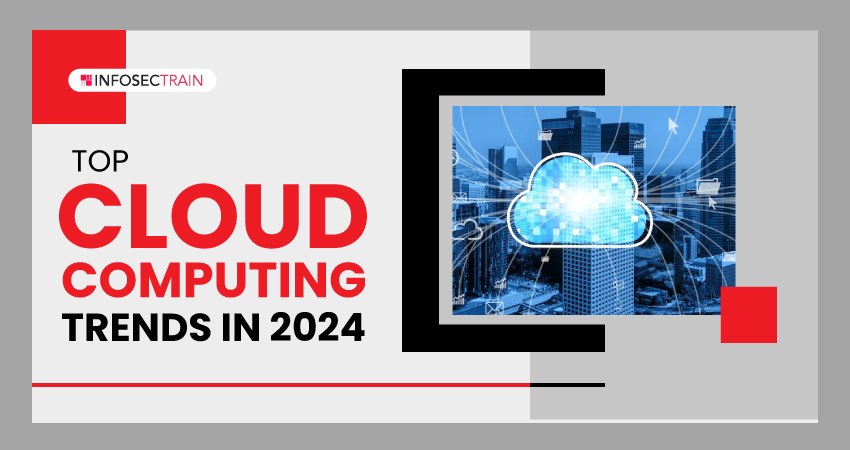Top Cloud Computing Trends In 2024
As we step into 2024, the landscape of cloud computing continues to evolve, promising exciting technological advancements and innovation. The year signifies a crucial period when cloud computing trends are set to revolutionize industries. From the integration of AI (Artificial Intelligence) into cloud services to the increasing adoption of serverless computing, these advancements transform how businesses operate and deliver services. Security enhancements, the expansion of edge computing, and the rise of hybrid and multi-cloud strategies mark pivotal changes, enabling organizations to leverage agility, scalability, and efficiency in unprecedented ways. Understanding these trends is crucial for unlocking the complete potential of cloud computing in the upcoming year.

Cloud Computing Trends to Watch in 2024
Here is the list of top cloud computing trends that are expected to continue or increase their significance in 2024:
- Artificial Intelligence (AI) as a Service (AIaaS): Integrating AI services into cloud offerings will likely expand further. AIaaS enables businesses to access pre-built AI models, tools, and APIs hosted on cloud platforms, allowing easier implementation of AI-driven functionalities without requiring deep expertise in AI.
- Cloud-native Development: Cloud-native approaches and technologies such as containers and microservices are expected to continue gaining momentum. The focus will be on developing applications specifically designed for the cloud environment, ensuring scalability, flexibility, and resilience.
- Data as a Service (DaaS): DaaS is witnessing substantial growth as businesses are increasingly interested in leveraging cloud-based platforms for streamlined access, handling, and analysis of extensive datasets. Cloud providers may offer more robust DaaS solutions, allowing easier data sharing and monetization.
- Edge Computing: Edge computing, which brings computation closer to the data source, is expected to expand. This trend caters to applications requiring low latency and high bandwidth, such as IoT, autonomous vehicles, and Augmented Reality/Virtual Reality (AR/VR).
- Hybrid and Multi-cloud Strategies: The adoption of hybrid and multi-cloud approaches is becoming more prevalent as organizations seek to minimize expenses, enhance resilience, and prevent dependency on single vendors. Companies will strategically distribute workloads across different cloud environments based on specific requirements.
- FinOps (Financial Operations): FinOps focuses on optimizing cloud costs without compromising performance. This trend is expected to continue as companies aim to manage cloud spending more effectively through better financial governance, analytics, and cost optimization strategies.
- Real-time Cloud Infrastructure: Real-time cloud infrastructure enables instant data processing and responses. In 2024, anticipate significant progress in real-time capabilities, specifically streaming analytics, IoT, and interactive applications. Cloud providers often provide specialized services and architectures to meet real-time processing demands.
- Serverless Computing: The adoption of serverless computing models will likely grow. These models allow developers to focus on code without managing infrastructure. Cloud providers might enhance serverless offerings, making deploying and scaling applications more accessible and cost-effective.
- Security and Compliance: Security and compliance will remain paramount in cloud computing. With the increasing focus on data security and regulatory compliance, cloud providers will continue prioritizing robust security measures, including encryption, identity management, and compliance tools to protect data and ensure adherence to regulations.
- Sustainability: In response to environmental concerns, cloud providers are expected to prioritize sustainable practices, including using renewable energy sources, implementing energy-efficient data centers, and initiating carbon-neutral initiatives. This prioritization of sustainability in cloud computing, aimed at reducing environmental impact through eco-friendly infrastructure and practices, will likely continue in 2024, aligning with global efforts toward environmental conservation.
Feel free to explore our cloud-related blogs:
- Edge Computing vs. Cloud Computing
- What is Cloud Computing Architecture and Its Components?
- What is Mobile Cloud Computing?
- What is a Load Balancer in Cloud Computing?
- Real-World Applications of Cloud Computing
- Top Cloud Computing Interview Questions
Cloud Computing with InfosecTrain
These trends in 2024 represent the continued evolution of cloud computing, addressing diverse business needs, technological advancements, and the growing importance of efficiency, security, and sustainability in the digital landscape.
InfosecTrain stands out as a leading training and consultancy firm, delivering top-notch instructor-led courses in cybersecurity, cloud computing, data privacy, and related fields. For those aspiring to embark on a career in cloud computing but still deciding where to start, InfosecTrain offers various cloud computing certification training courses tailored to provide the essential knowledge. These courses are meticulously crafted to equip individuals with the vital skills required to thrive across multiple career trajectories within the cloud computing domain.






 1800-843-7890 (India)
1800-843-7890 (India)